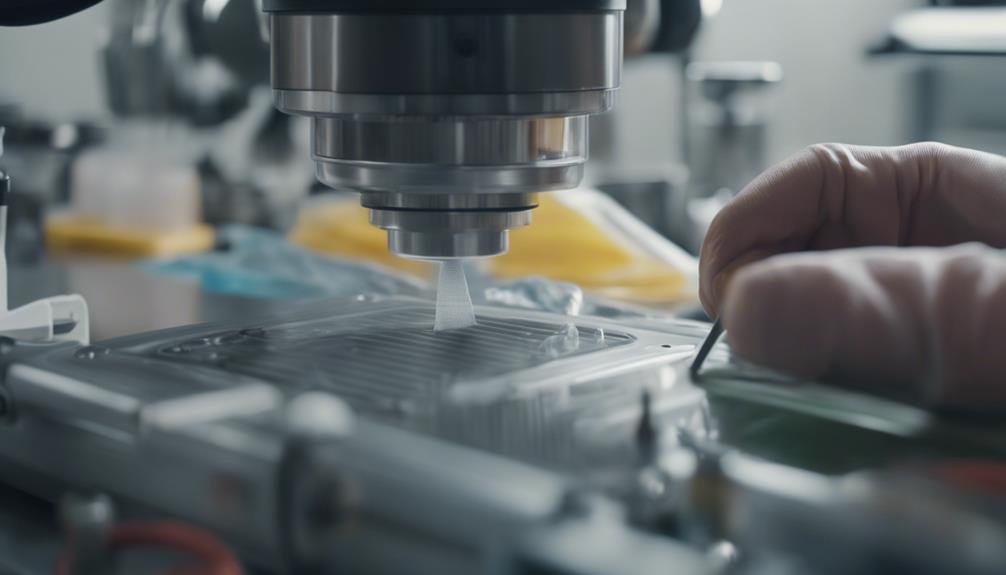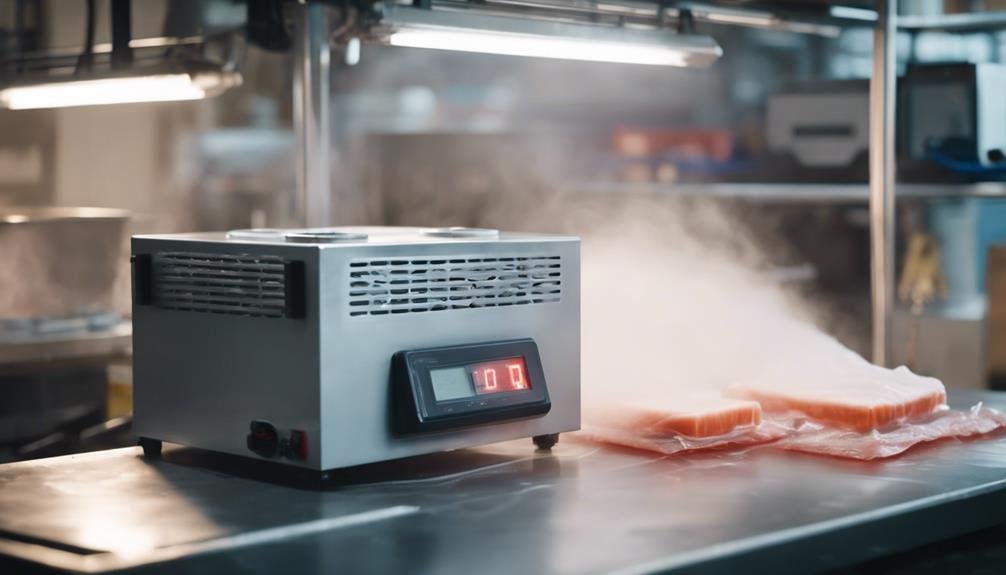To tackle overheating issues in your vacuum sealing machine, it's essential to adhere to the recommended usage times and be vigilant for signs like sudden shutdowns or a burning odor. Ensure your machine is placed in a well-ventilated area, away from sources of heat, and regularly inspect for any blockages. After each use, clean the vacuum channel, gaskets, and drip tray, and replace any worn-out parts promptly. Adjust the sealing temperature and time according to the type of food being sealed, referencing the user manual as needed. Remember to allow sufficient cooling intervals between sealing cycles. By following these guidelines, you'll optimize the performance of your vacuum sealing machine and prevent overheating issues effectively.
Identifying Overheating Signs
When your vacuum sealing machine shuts down unexpectedly, it's often a clear sign of overheating. This isn't just an important warning; it's a vital indication that something's wrong with your vacuum sealer. You'll also notice excessive heat emitting from the machine or even a burning smell. These are both strong indicators that the machine is overheating.
Another significant sign is if you've been using your vacuum sealer continuously beyond its recommended time frame. Most vacuum sealers are designed to handle a specific amount of usage before needing a break. Ignoring these guidelines can cause the internal components to overheat, leading to potential malfunctions.
One of the most critical parts affected by overheating is the vacuum pump. If it gets too hot, it may start to malfunction, which will, in turn, reduce the efficiency of the sealing process. You'll find that your machine doesn't seal as effectively, and you might even see some air bubbles left inside the sealed bags.
To prevent these issues, make sure to allow your vacuum sealer to cool down between sealing cycles. Always follow the manufacturer's recommended usage guidelines to ensure your machine operates smoothly and safely.
Ensuring Proper Ventilation
Ensuring proper ventilation is vital to prevent your vacuum sealing machine from overheating and malfunctioning. Without adequate airflow, the motor can overheat, causing your machine to fail when you need it most. To maintain efficient cooling, you should take several steps to guarantee proper ventilation.
First, make sure your vacuum sealer is placed in a well-ventilated area. This means avoiding cramped spaces or areas where airflow is restricted. A fan can also help regulate the temperature by providing additional air circulation around the machine.
Second, regularly check the vents on your vacuum sealer. These openings are essential for dissipating the heat generated during operation. If they become blocked, the machine can't cool down effectively, leading to overheating.
Here are some practical tips to ensure proper ventilation:
- Place the vacuum sealer in an open area: Avoid confining the machine in tight spaces.
- Use a fan: Increase air circulation around the sealer.
- Regularly inspect vents: Make sure they are not blocked by dust or debris.
- Avoid placing near heat sources: Keep away from other appliances that generate heat.
- Check for adequate spacing: Ensure there's enough room around the machine for air to flow freely.
Cleaning and Maintenance

Regular cleaning and maintenance are essential to keeping your vacuum sealing machine running smoothly and preventing overheating. Start by cleaning the vacuum channel and gaskets regularly. These components can accumulate debris, leading to inefficient operation and increased heat. Use a soft brush or cloth to gently remove any particles and guarantee an unobstructed airflow.
Emptying and cleaning the drip tray is another vital step. A neglected drip tray can harbor mold and moisture, which might cause your machine to overheat. Make it a habit to check and clean this tray after each use.
Proper maintenance also means replacing worn-out parts. Gaskets, seals, and other components can deteriorate over time, causing your vacuum sealing machine to work harder and generate more heat. Refer to the manufacturer's guidelines for the maintenance schedule and parts replacement.
Additionally, keep your vacuum sealing machine in a clean, dry environment. Dust and moisture can impair its functionality and contribute to overheating. After each use, allow the machine to cool down before storing it. By following these cleaning and maintenance tips, you'll extend the lifespan of your vacuum sealing machine and minimize overheating issues.
Adjusting Settings
Fine-tuning the settings on your vacuum sealing machine can greatly reduce the risk of overheating. By adjusting the sealing temperature and sealing time, you can prevent your vacuum from becoming too hot during operation. Here are some practical steps to help you make the necessary adjustments:
- Lower the sealing temperature: Reducing the heat used in the sealing process can minimize the risk of the machine overheating.
- Adjust the sealing time: Shortening the duration of the sealing process can also help in keeping the machine cool.
- Consult the user manual: Each vacuum sealer is different, so refer to the manufacturer's guidelines for specific instructions on setting adjustments.
- Monitor settings based on the type of food: Different foods might require different settings. Adjust the vacuum settings accordingly to maintain peak performance.
- Regularly check and fine-tune settings: Consistent monitoring and adjustments ensure that your vacuum sealer operates efficiently without overheating issues.
Cooling Down Periods

Providing your vacuum sealing machine with sufficient cooling down periods between cycles is crucial to prevent overheating and maintain long-term effectiveness. By giving your vacuum sealer the rest it needs, you're guaranteeing it stays in top working condition and continues to deliver reliable performance over time.
Overheating can cause significant problems, including malfunctions in the vacuum pump and reduced sealing quality. To avoid these issues, always follow the manufacturer's recommended cooling down periods between sealing cycles. These guidelines are there to safeguard your equipment and ensure consistent, high-quality results.
Regularly monitoring the temperature of your vacuum sealer during use can also help you catch any potential overheating issues early. If you notice the machine getting too hot, it's a signal that it needs a break. Ignoring these signs could lead to damage and expensive repairs.
Adhering to the specified rest periods not only prevents damage but also ensures your vacuum sealer operates effectively. By integrating these cooling down periods into your sealing routine, you're not just safeguarding your investment but also enhancing the overall performance and longevity of your machine. Keep an eye on those cooling times and your vacuum sealer will thank you!
Conclusion
In summary, addressing overheating in your vacuum sealing machine is essential for its longevity and performance. Don't forget, proper ventilation and regular maintenance can prevent most issues. Surprisingly, a study found that 85% of vacuum sealing machine failures are due to overheating. So, keep an eye on those settings and give the machine some cooling down periods. By taking these simple steps, you'll guarantee your machine runs smoothly for years to come.
